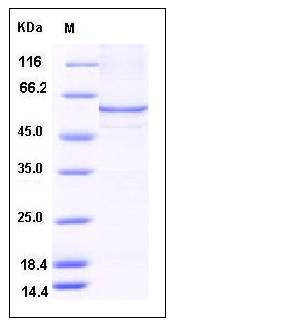Human CAT / Catalase Protein (His Tag)
MGC138422, MGC138424
- 100ug (NPP3642) Please inquiry
| Catalog Number | P12084-H07B |
|---|---|
| Organism Species | Human |
| Host | Baculovirus-Insect Cells |
| Synonyms | MGC138422, MGC138424 |
| Molecular Weight | The recombinant human CAT consists of 545 amino acids and predicts a molecular mass of 61.9 kDa. It migrates as an approximately 60 kDa band in SDS-PAGE under reducing conditions. |
| predicted N | Met |
| SDS-PAGE |  |
| Purity | > 80 % as determined by SDS-PAGE |
| Protein Construction | A DNA sequence encoding the human CAT (P04040) (Ala 2-Leu 527) was expressed, with a polyhistidine tag at the N-terminus. |
| Bio-activity | |
| Research Area | Signaling |Signal Transduction |Metabolism |Pathways and Processes |Metabolism processes |Apoptosis | |
| Formulation | Lyophilized from sterile 50mM Tris, 100mM NaCl, pH 8.0, 10% gly 1. Normally 5 % - 8 % trehalose, mannitol and 0.01% Tween80 are added as protectants before lyophilization. Specific concentrations are included in the hardcopy of COA. |
| Background | Catalase is a ubiquitously expressed enzyme that catalyzes the decomposition of hydrogen peroxide to water and oxygen. It is a tetramer of four polypeptides chains containing four porphyrin heme groups that allow the enzyme to react with the hydrogen peroxide. The optimum PH of human catalase is approximately 7 and the optimum temperature is at 37 degree. Both the PH optimum and temperature for other catalases varies depending on the species. Catalase can be inhibited by a flux of O2- generated in situ by the aerobic xanthine oxidase reaction. This inhibition of catalase by O2- provides the basis for a synergism between superoxide dismutase and catalase.Such synergisms have been observed in vitro and may be significant in vivo. Catalase is used in the food industry for removing hydrogen peroxide from milk prior to cheese production. Another use is in food wrappers where it prevents food from oxidizing. Catalase is also used in the textile industry, removing hydrogen peroxide from fabrics to make sure the material is peroxide-free. |
| Reference |
